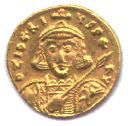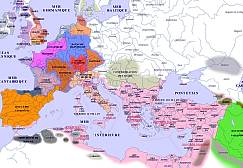
An Online Encyclopedia of Roman Emperors
Tiberius III(II) (698-705 A.D.)
R. Scott Moore
Indiana University of Pennsylvania

An Online Encyclopedia of Roman Emperors
Tiberius III(II) (698-705 A.D.)
R. Scott Moore
Indiana University of Pennsylvania
 (c)
1999 Chris Connell
(c)
1999 Chris Connell
Revolt and Accession
In 697 AD, the caliph cAbd al-Malik carried out a successful attack on Byzantine Africa that resulted in the capture of Carthage. The emperor Leontius sent a naval fleet under the command of John the Patrician to retake Byzantine Africa. Following a surprise attack on Carthage that allowed John to seize the city, Arab reinforcements soon forced John's troops to retreat to the safety of Crete. Fearing the emperor's anger at their failure, a group of naval officers revolted, murdered John and proclaimed Apsimar, drungary of the Cibyrrhaeots, as the emperor Tiberius II. Tiberius gathered a fleet and sailed to lay siege to Constantinople which was being ravaged by a plague. The city withstood the siege for several months, before the gates were opened for the rebels in 698 by supporters of the Green faction. Tiberius II, had Leontius' nose slit and him imprisoned in the monastery of Psamathion in Constantinople.
Reign
Tiberius made no attempt to retake Byzantine Africa and focused instead on the eastern edges of the empire. He appointed his brother, Heraclius, as monostrategos and allowed him to wage numerous campaigns in Asia Minor. While moderately successful initially, the Byzantines soon lost Armenia to the Arabs. Tiberius did make an attempt to strengthen the empire militarily by reorganizing its administration. He repaired the sea walls surrounding Constantinople and repatriated Cypriots who had been sent to the Cyzicus region during Justinian II's reign.
Downfall
In 703, Tiberius learning of Justinian II's escape from Cherson and attempts to gain support from the Khazars, sent envoys to the Khazars to demand that they turn over Justinian to imperial officials. In August 705, Tiberius fled Constantinople when he was informed that Justinian II was approaching the city with a large army. He was able to elude captivity for several months, but was eventually captured. Justinian II had Tiberius and Leontius paraded through the city before they were beheaded.
Primary Source Bibliography
Nicephorus. Chronigraphikon syntomon.
Theophanes. Chronographia.
Bibliography
Bury, J.B. The Later Roman Empire from Arcadius to Irene (395-800). London, 1889.
Haldon, J.F. Byzantium in the Seventh Century: the transformation of a culture. Cambridge, 1990.
Kaegi, Jr. Walter Emil. Byzantine Military Unrest, 471-843: an interpretation. Amsterdam, 1981.
Kazhdan, Alexander P. Oxford Dictionary of Byzantium. New York, 1991. S.v. "Tiberios II" by Paul A. Hollingsworth.
Kulakovskij, J. Istorija Vizantii, 3 vols.. (Kiev 1912-1915).
Ostrogorsky, George. Geschichte des byzantischen Staates. Munich, 1963.
Stratos, A.N. Byzantium in the Seventh Century. Amsterdam, 1968.
Treadgold, Warren. A History of Byzantine State and Society. Stanford, 1997.
Vasiliev, A.A. History of the Byzantine Empire. Madison, Wisconsin,
1952.
Copyright (C) 1999, R. Scott Moore. This file may be copied on the condition that the entire contents, including the header and this copyright notice, remain intact.
Comments to: R. Scott Moore
Updated: 26 May 1999
For more detailed geographical information, please use the DIR/ORBAntique and Medieval Atlas below. Click on the appropriate part of the map below to access large area maps.
